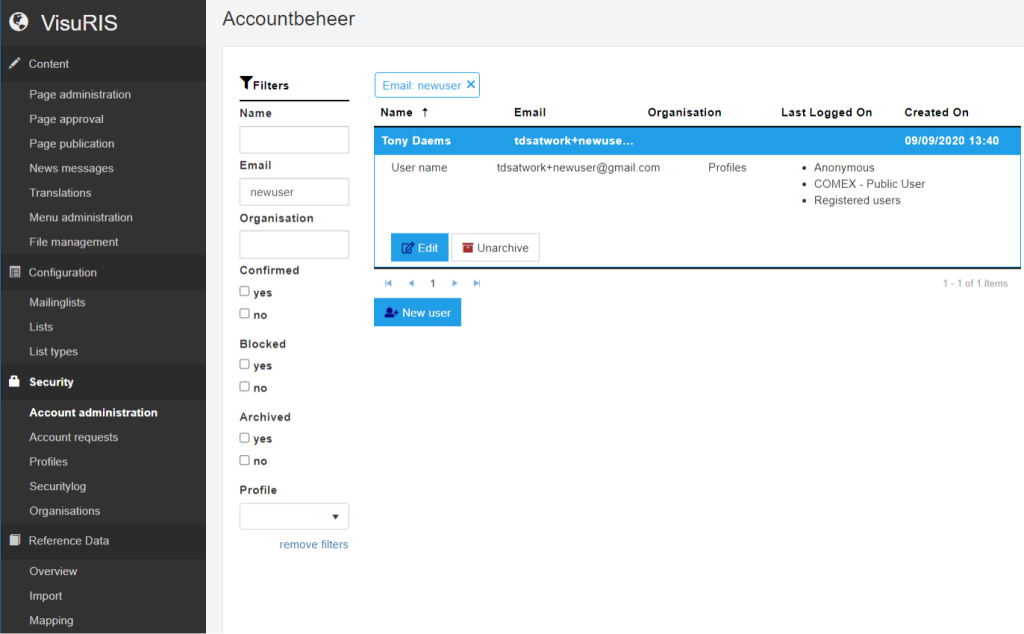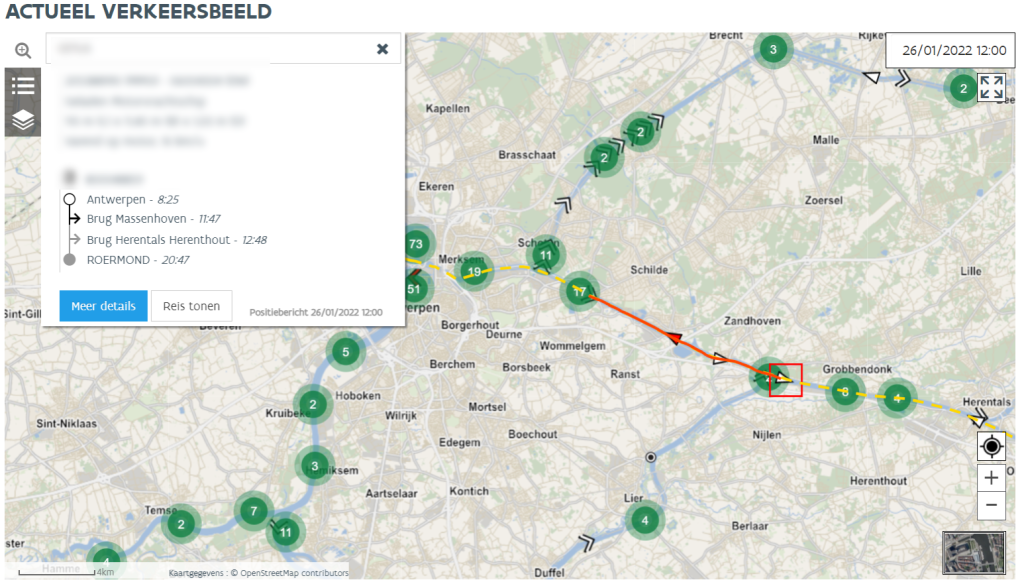Software development
ALSIC’s software department provides custom solutions, developing software made to specific needs, both as a turn-key project or as part of a project, particularly for Inland Waterways Transport and Supply Chain Management solutions.
We use different Analysis techniques and DevOps Agile strategies for development on various platforms and programming languages.
Together, we choose the most adequate development environment to cover your needs, the existing development and application maintenance in the long term.
One of our key stones to do this is our in house developed ALSIC.Web framework (AWF).
Websites using ALSIC.Web framework (AWF)
 This platform is used for easier and faster web development.
This platform is used for easier and faster web development.
It is based on the .NET Framework and includes a full-fledged Content Management System, which we use to streamline and support web application development.
It can be used in various deployments such as web farms.
We develop modules (widgets) to fulfill customer needs. These modules can be managed and configured, using a CMS. It also allows to provide API’s. These API’s can be used externally (open/protected data) and/or by the front end GUI using responsive web design principles.
AWF allows a custom look & feel with a flexible structure, using skin sets with different possible lay-outs, from the classic 5 part (header, left, content, right and footer) to portal configurations with many zones. It supports many different types of applications including geographic visualisations, timeseries, display of real time data, …
 A user-friendly Content Management System:
A user-friendly Content Management System:
- Module-based: can be a news module, HTML text, image album, web service frontend… More than 100 modules are available.
Content managers can define pages and insert modules each with its own specific content editor. - CMS workflows: such as create, review, test and publish.
- Version Management: when necessary, you can go back to an older version of a webpage.
- Multiple language support: AWF can remember the language selected by the user.
 One of the biggest challenges is to visualize real-time information on geographic maps in a user friendly fashion. AWF contains support for geographic presentations using different GIS frameworks. ArcGIS JavaScript API and Leaflet.NET are supported out of the box. We can also provide custom rendered tile maps based upon OpenStreetMap data (e.g. the VisuRIS background map).
One of the biggest challenges is to visualize real-time information on geographic maps in a user friendly fashion. AWF contains support for geographic presentations using different GIS frameworks. ArcGIS JavaScript API and Leaflet.NET are supported out of the box. We can also provide custom rendered tile maps based upon OpenStreetMap data (e.g. the VisuRIS background map).
Information is captured from different sources such as custom spatial services providing real-time data, WMS and WFS, ArcGIS Mapservices, OGCApi services, GeoJSON, …. We can display it on different styled background maps using OpenStreetmap data, ECDIS charts, vector based maps, … Depending on the needs of the customers.
Examples:
- Realtime AIS tracks (moving vessels)
- Flood forecasting results
- Hydro and weather information
- Notices to skippers
- Voyage computation
AWF is built with security in mind and used in both internet and intranet solutions.
The administrator has various security tools.
We also support the use of a federated authentication/authorization solution using Identity Server supporting Single Sign-On (SSO) in various configurations.
- Single Sign-On support using an authentication gateway
- Roles can be created for view or admin rights
- Dynamic menus only show pages which the user has access to
- Account management and monitoring tools to ease the burden on administrators

AWF is used in very demanding environments, e.g.:
- Portal sites (vts-scheldt.net, European edition of VisuRis,…)
- Flood forecasting (Waterinfo.be)
- Traffic monitoring (VisuRis.be)
- Calamity monitoring (C@LRIS)
- Notices to skippers
with availability requirements of 99,9%.
AWF is active in various configurations such a clusters and network load balancing (NLB) with high performance through the use of distributed cache configurations.
Instances in various remote datacenters are supported through database replication.
Business Intelligence
ALSIC recognized the need for Business Intelligence very early on as added value for sharing and analyzing information within a company.
Companies spend a lot of money on transactional systems to generate valuable information. Often with poor reporting capabilities like spreadsheets, which don’t allow sharing of key information between or inside departments.
We apply the CIF model for data warehouses:
- Subject-oriented: The data in the data warehouse is organized so that all the data elements relating to the same real-world event or object are linked together.
- Integrated: The data warehouse contains data from most or all of an organization’s operational systems (different data sources) and these data are made consistent with each other. This is the most important aspect of a data warehouse.
- Non-volatile: Data in the data warehouse is never over written or deleted. If data changes a historical record is kept in the data warehouse.
- Time-Variance: Every piece of data in the warehouse has is accurate in particular moment in time. The key structure of the data should always be provided with a time element.
ALSIC provided many different large business intelligence solutions for mainly the following domains:
- Transport, cargo and traffic
- Detailed tracing of routes using AIS data
- Hydro meteo
- Supply chain management
- …
We like to use the MS SQL Server solution for configuring a complete Business Intelligence solution using integration services (ETL), SQL server (database warehouses) and analysis services to provide additional intelligence.
PowerBI is often used as the reporting tool (as a successor of SQL reporting services). Sometimes we also uses GIS components to provide spatial reports.
Examples:
AIS Track analysis to indicate the most used routes. This is information is also used to know where e.g. new windmill parks can be placed.
PowerBI – interactive dashboards
Inland Waterway Transport / Supply Chain Management
ALSIC has a team of experts when it comes to RIS Key Technologies and Inland Waterway Transport, to perform studies, software projects and project management.
ALSIC is highly active in several European Working Groups (CESNI/TI), f.e. CESNI/TI/NtS and CESNI/TI/ERI, where our team is involved to modernise these European Standards and used technologies.
Our team combines high end technologies with knowledge of business processes, Inland Waterway Transport and the European River Information Standards (RIS), to create useful solutions for governments, skippers, barge operators, harbours, pleasure craft users and many others.
ALSIC successfully created many solutions in this area:
- VisuRIS
- EuRIS (COMEX-project)
- Automation of Inland Voyage Reporting
- Hull & Crew Database (ECDB and EHDB)
- eRIBa (Electronic Reporting Portal)
- Lock Planning software
- Flanders RIS Business Intelligence System
- Notices to Skippers
- Calamity Abatement Support software (C@LRIS)
- Etc.
Automatic identification system (AIS)
Over the years we developed our expertise with Automatic identification systems (AIS), an automatic tracking system using transponders on ships, used by vessel traffic services (VTS). This automated system transmits a ship’s position to make other ships aware of its position, as a supplement to radar systems and to avoid collisions. This information is also used for Vessel Traffic Services and River Information Services.
Here are some of our solutions for AIS:
- AIS viewers
- Filters and gateway modules (distribution)
- Realtime geofencing and geo based security
- Data sharing
- Long (statistics and analysis) & short term (track overview) storage solutions
- Analysis solutions and reporting


